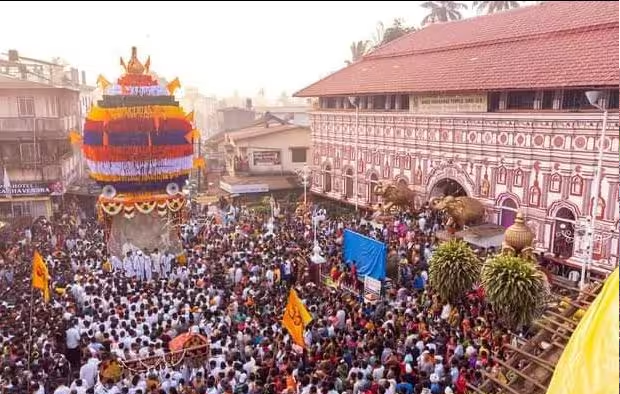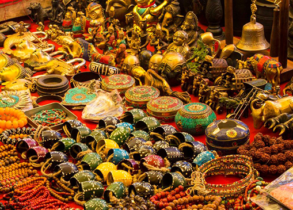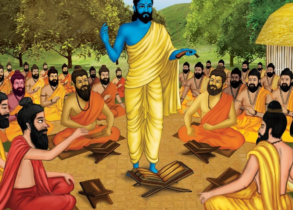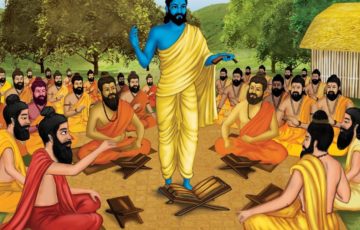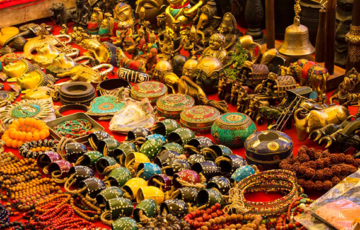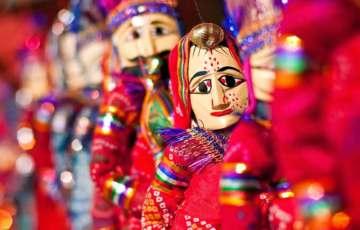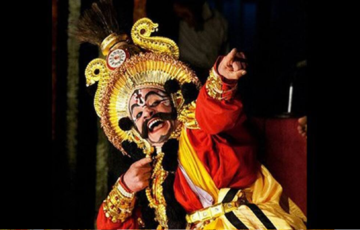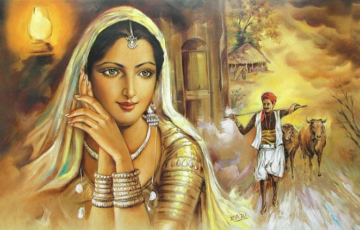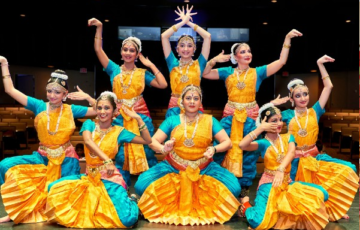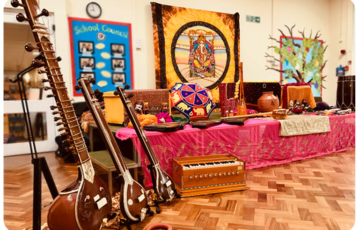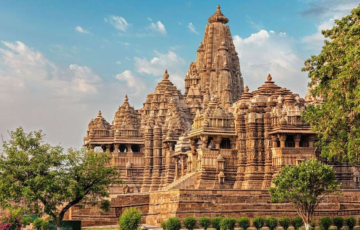INDIAN FAIRS AND FESTIVALS
Introduction
- Festivals and fairs are intricately woven into the rich tapestry of Indian culture, serving as profound expressions of our beliefs and emotions. Despite the unique observances of festivals and holy days by various communities, India’s secular ethos ensures active participation in these celebrations by people from diverse religious backgrounds. The nation’s commitment to inclusivity is evident in the designation of holidays for numerous festivals representing a wide array of faiths and communities.
- Within this vibrant cultural tapestry, certain festivals find themselves on the ‘restricted list,’ granting employers the discretion to choose whether to observe them as holidays. Beyond their religious significance, these festivals play a pivotal role in unraveling the layers of India’s diverse cultural heritage. Even individuals from foreign lands seamlessly integrate into these vibrant celebrations as part of their travel experiences, acknowledging these festivals as integral components of India’s cultural identity.
26th January – Republic Day:
15th August – Independence Day:
2nd October – Gandhi Jayanti:
|
Religious festivals
- Religious festivals serve as significant celebratory occasions for specific communities adhering to distinct belief systems or religions. Despite their roots in religious traditions, these festivals often embody inclusivity, with no inherent restrictions preventing individuals from different faiths from actively participating in the festivities. A noteworthy example is Holi, originally a Hindu religious festival, which sees enthusiastic participation from people of various faiths in the secular landscape of India. The following compilation underscores festivals celebrated by specific communities across the country, collectively contributing to the rich and diverse cultural mosaic of India.
Hindu festivals:
Diwali or Deepawali:
- Celebrated on the New Moon (Amavasya) day in the month of Kartik (October and November).
- The day before Diwali is known as Naraka Chaturdashi.
Dev Deepawali:
- Celebrated in Varanasi (Uttar Pradesh) on the full moon of the Hindu month of Kartika (November-December).
- Takes place 15 days after Diwali.
- Tradition of lighting lamps on the ghats of River Ganga.
Holi:
- The festival of colors celebrated across religions.
- Falls in the month of Phalguna (February-March).
- Signifies the victory of good over evil, symbolized by the burning of Holika and the saving of Bhakt Prahlad.
- Known as Dol Jatra in West Bengal and parts of Assam.
Makara Sankranti:
- Celebrates the transition of the Sun in the Northern hemisphere.
- Celebrated in the month of January.
- Pilgrimage to Gangasagar (in West Bengal) and Prayagraj for a holy dip.
- Kite Flying Festival in some places.
Janmashtami:
- Celebrates the birth anniversary of Lord Krishna.
- Generally falls in the month of August.
Dussehra (Vijaya Dashami):
- Celebrated pan India to honor the victory of Lord Rama over Ravana.
- Ravana Dahan is a common feature, especially in North India.
Durga Puja:
- Majorly celebrated in the Eastern part of India, especially West Bengal.
- Celebrates Goddess Durga’s triumph over demon Mahisasura.
Ganesh Chaturthi:
- Celebrates the birth anniversary of Lord Ganesha.
- Celebrated pan India, with grand festivities in Maharashtra.
Rath Yatra (Chariot Festival):
- Biggest festival in Odisha, dedicated to Lord Jagannath, Balabhadra, and Subhadra.
- The Ratha Yatra of Puri is the largest and well-known.
Chhath Puja:
- Main festival of Bihar and Jharkhand.
- Honors Sun Goddess with rituals, fasting, and offerings.
- Thekua, a sweet dish, is a special attraction.
Nabakalebar Festival:
- Observed at Shri Jagannath temple, Puri (Odisha) after 8 to 19 years.
- Involves replacing the idols of Lord Jagannath, Balabhadra, Subhadra, and Sudarshan with new idols carved from selected neem trees.
- Attracts lakhs of pilgrims who worship the neem tree and witness the idol replacement ceremony.
- In March 2018, commemorative coins of Rs 1000 and Rs 10 were released by the President of India on the occasion of the Nabakalebar festival.
Muslim festivals:
Eid-ul-Fitr:
- Celebrated after the last day of the holy month of Ramadan.
- People fast from sunrise to sunset during Ramadan.
- The date is calculated for the first day of the month of Shawwal, after the appearance of the moon at the end of Ramadan.
- Marks the end of Ramadan, the month when the Holy Quran was revealed.
Eid-ul-Zuha or Eid-al-Adha:
- Also known as Bakr-Eid or the Festival of Sacrifice.
- Celebrated on the 10th day of Dhu-al-Hijjah, the 12th month of the Islamic calendar.
- Honors Prophet Ibrahim’s devotion to Allah, symbolized by the sacrifice of a goat.
- 1/3rd of the sacrificial meat is given to the poor.
- Marks the beginning of the sacred period of Hajj pilgrimage to Mecca.
Milad-un-Nabi:
- Also known as Barah-wafat, the birth anniversary of Prophet Muhammad.
- Celebrated on the 12th day of Rabi-al-Awwal, the 3rd month of the Muslim calendar.
- Subdued celebrations as it is also considered the day of the Prophet’s departure from earth.
- Often involves reading the Holy Quran, reciting sacred poems, and singing traditional songs in honor of the Prophet.
Muharram:
- A sad festival associated with the death of Hussain, son of Ali.
- Falls in the first month of the Islamic calendar, Muharram.
- The 10th day, Yaum-al-Ashura, is a day of mourning for Shia Muslims worldwide.
- Commemorates the martyrdom of Hussain Bin Ali in the battle at Karbala.
Shab-e-Barat:
- Also known as the ‘Night of Emancipation.’
- Observed on the night between the 14th and 15th day of the month of Shaban.
- Destiny is believed to be determined on this night.
- Celebrated by Shia Muslims as the birth anniversary of Imam Muhammad Al-Mahdi.
Shab-e-Miraj:
- Means the “Night of Ascent.”
- Believed to be the night when the Holy Prophet continued his journey and reached near Almighty.
- Occurred on the 27th day of Rajab, two years before Hijra.
- The journey is associated with the obligation of five daily prayers for Muslims.
- Mosques are decorated, and Muslims engage in hymns, praising the Prophet, charity, and food distribution to the poor.
Christian Festivals
Christmas
Celebrated globally on December 25th, Christmas commemorates the birth of Jesus Christ. Festivities begin with a midnight mass on December 24th, symbolizing the moment of Christ’s birth. People attend church services, exchange gifts, and participate in traditions such as decorating Christmas trees. Santa Claus, a symbol of generosity, plays a significant role in the celebrations.
Easter and Good Friday
Easter marks the resurrection of Jesus Christ, symbolizing victory over death. Good Friday, observed in April, honors Christ’s crucifixion. The date of Easter, determined during the Council of Nicene in 325 AD, falls on the first Sunday after the first full moon following the vernal equinox.
Sikh Festivals
- Gurpurab: Sikhs worldwide celebrate Gurpurab, commemorating the birth anniversaries of Sikh gurus, with a focus on Guru Nanak and Guru Gobind Singh. Festivities include Akhand Path, congregational singing, and processions with the Guru Granth Sahib.
- Maghi: Celebrated in Muktsar, Maghi honors Sikh martyrs. Sikhs participate in processions, taking a sacred bath in Muktsar’s waters to remember the sacrifice of the 10th Guru Govind Singh.
- Hola Mohalla: Known as the “Sikh Olympics,” Hola Mohalla involves mock battles, military exercises, and competitions. Held in Anandpur Sahib, it showcases Sikh valor and martial arts prowess.
- Vaisakhi/Baisakhi: Celebrated on April 13 or 14, Vaisakhi marks the Sikh New Year and the creation of the Khalsa Panth. Sikhs engage in religious ceremonies, visit temples, and indulge in festive foods.
Jain Festivals
- Mahavir Jayanti: Mahavir Jayanti celebrates the birth of Lord Mahavira on the 13th day of Chaitra. Temples are adorned, and Mahavira’s idol undergoes a ceremonial bath and procession.
- Paryushana: Jains observe Paryushana for eight days (Svetambara sect) or ten days (Digambara sect) in Bhadrapada. It commemorates the retreat of Jain monks during the monsoons and includes temple visits, discourses, and forgiveness rituals.
- Mahamastakabhisheka: Held every 12 years in Shravanabelagola, this festival involves the bathing ceremony of the 57-ft statue of Siddha Bahubali with milk, saffron, and other offerings.
- Gyana Panchami: Celebrated on the fifth day of Kartika, Gyana Panchami focuses on knowledge. Holy Scriptures are displayed and worshipped during this Jain festival.
- Maun-Agiyara: Observed on the 11th day of Magshar, Maun-Agiyara is a day of complete silence, fasting, and meditation in the Jain tradition.
- Navapad Oli: Navapad Oli is a nine-day semi-fasting period observed by Jains, during which individuals consume only one meal a day consisting of plain food. This observance occurs twice a year, in March/April and September/October.
Buddhist Festivals
Buddha Purnima
- Buddha Purnima, also known as Buddha Jayanti, commemorates the birth anniversary of Lord Buddha. Celebrated in April/May, it is widely observed in North-East India. Referred to as Saga Dawa (Dasa) in Sikkim and Vishakha Puja in the Theravada tradition, prominent celebration locations in Northern India include Sarnath in Uttar Pradesh and Bodh Gaya in Bihar.
- Festivities encompass ritualistic prayers, sermons on the life of Gautam Buddha, chanting of Buddhist scriptures, worshipping the image of Buddha and the Bodhi tree, and meditation. Different sects follow unique practices, with Mahayana Buddhists organizing processions featuring musical instruments like gyalings and reading Kangyur texts. Theravada Buddhists focus on offering ceremonial prayers to Buddha idols.
Songkran
- Songkran, a Buddhist festival observed as a spring cleaning event, spans several days in mid-April. During this time, people engage in cleaning their homes, washing clothes, and joyfully sprinkling perfumed water on monks.
Ploughing Festival
- Celebrated in May, the Ploughing Festival marks Buddha’s first moment of enlightenment at the age of seven when he observed ploughing with his father. In this festival, two white oxen pull a gold-painted plough, followed by four girls dressed in white who scatter rice seeds from baskets.
Ulambana
- Ulambana is observed from the 1st to the 15th day of the eighth lunar month. Believed to be a time when the gates of Hell open, allowing ghosts to visit the world for fifteen days, offerings of food are made during this period to alleviate the suffering of these spirits. On the 15th day, known as Ulambana or Ancestor Day, people visit cemeteries to make offerings to departed souls.
Hemis Gompa Festival
- The Hemis Gompa festival is an annual celebration held at the Hemis Gompa Monastery in Ladakh to commemorate the birth anniversary of Guru Rinpoche (Padmasambhava). This festival symbolizes the triumph of good over evil, as Guru Padmanasambhava, the founding figure of Tibetan Buddhism, engaged in a struggle against malevolent forces to safeguard his people.
- The festival’s focal point is the mesmerizing mask dance performed by the Lamas, accompanied by the enchanting sounds of traditional instruments such as cymbals, large-pan drums, small trumpets, and large wind instruments.
Sindhi Festivals
Chaliho Sahib
- Chaliho Sahib is a 40-day fasting observance practiced by Sindhis in July-August. Participants fervently pray to Lord Jhulelal for 40 days, and upon completing the fast, the Sindhi community celebrates the occasion as Thanks Giving Day.
- The festival traces its origin back to the period when Mirkshah Badshah, a Muslim invader of Sindh, posed a threat to the people of Thatta. In response, the community sought the intervention of Varun Devta (God of Water) through 40 days of penance on the riverbanks. On the 40th day, Varun Devta answered their prayers through Jhulelal.
Cheti Chand
- Cheti Chand marks the Sindhi New Year, observed on the first day of Chaitra. It pays homage to the birth of Jhulelal, the revered patron saint of Sindhis. Celebrated with great zeal, the Sindhi community participates in the Baharana Sahib ritual, including Jyot, Misiri, Phota, Fal, Akha, carried to nearby rivers. The festivities also involve the procession of an idol of Jhulelal Devta.
Parsi or Zoroastrian Festivals
Jamshedi Navroz
- Jamshedi Navroz is the Parsi New Year celebration, occurring on the first day of the first month (MahFrawardin) of the Shehanshahi calendar. It marks the transition from winter to the New Year. Traditionally, Parsis pay homage to Khorshed and MeherYazads, divine beings associated with the Sun, and engage in visits to one another and the Fire Temple.
Pateti Festival
- The Pateti festival is celebrated on the final day of the Persian calendar year. It symbolizes the commencement of a new year with a clean slate, signifying the burning of the previous year’s transgressions in front of the holy fire. The day includes various rituals, such as home cleaning, Rangoli drawings, incense lighting, and the preparation of special meals.
Gahambars
- Gahambars, known as seasonal festivals, occur six times a year in the Zoroastrian tradition. Each Gahambar pays tribute to God’s six worldwide creations, reaffirming the sanctity of God’s creation. The six Gahambars include events such as Maidyozarem Gahambar, Maid Yaoi-Shema Gahambar, Paitishahema Gahambar, Ayathrem Gahambar, Maidyarem Gahambar, and Hamaspathmaidyem Gahambar.
Zarthost No Deeso
- On the 11th day of the 10th month (Khorshedroz, Daemah) in June, Zoroastrians visit the Fire Temple to offer prayers and engage in discussions about the life and teachings of the prophet Zoroaster. It is a day of remembrance and worship, featuring activities at the fire temples and reflections on the prophet’s legacy.
Khordad Sal
- On the sixth day of the Parsi month of Farvardin (August/September), Khordad Sal celebrates the birth anniversary of the Prophet. Zoroastrians participate in special prayers and jashan ceremonies, embellish their homes, don fresh garments, and savor delectable feasts. The occasion serves as a time for contemplation and planning for the future.
Secular Festivals
Khajuraho Dance Festival
- The Khajuraho Dance Festival, established in 1975 by the Government of India in collaboration with the Madhya Pradesh Kala Parishad, serves the dual purpose of promoting tourism in the state and showcasing the beauty and inherent artistry of the Khajuraho temples. This festival not only celebrates dance but also embodies the enduring spirit of cultural heritage represented by both dance and architectural monuments.
New Year
- Celebrated across India under various names, New Year signifies the commencement of the Hindu calendar. Rooted in local traditions attributing the creation of the world to Lord Brahma on this day, different regions celebrate it with unique names such as Ugadi or Chaitra Shudhdha Paadyami in Andhra Pradesh and Karnataka, Gudi Padwa or Gudi Padvo in Maharashtra, Samvatsar Padvo in Goa, Naba Barsha (Poila Boisakh) in West Bengal, Puthandu in Tamil Nadu, and Vishu in Kerala.
Sair-e-Gul Faroshan
- Known as “Phool Walon Ki Sair” (Festival of Flower Sellers), this three-day festival in Delhi symbolizes communal harmony. It features a procession of palm leaf fans adorned with flowers, starting from the tomb of Khwaja Bakhtiyar Kaki in Mehrauli and culminating at the Yogmaya Temple. Originally patronized by Mughal Emperor Akbar II in the 19th century, the festival was reinstated in 1962 by J. L. Nehru after being banned during the British rule.
Tyagaraja Aradhana
- An annual festival, Tyagaraja Aradhana, commemorates the ‘Samadhi’ day of the renowned Telugu Saint and composer Tyagaraja. Held in Andhra Pradesh and Tamil Nadu, primarily at Thiruvaiyaru where he attained Samadhi, the festival attracts leading exponents of Carnatic music who gather to pay tribute to the saint. Tyagaraja, along with Muthuswami Dikshitar and Syama Sastri, collectively forms the Trinity of Carnatic music.
Onam
- Onam, the State festival of Kerala, marks the harvest season and the homecoming of King Mahabali from Patala. Celebrated with elaborate feasts, dances, flowers, boats, and elephants, Onam features the Vallam Kali (Snake Boat race) held in Punnamada Lake. Traditional games, known as Onakanikal, are also an integral part of the vibrant festivities.
Pongal
- Pongal, a four-day harvest festival celebrated by Tamils worldwide in January, marks the beginning of the Sun’s northward journey. The festival involves boiling the first rice, symbolizing prosperity. The four days include Bhogi festival, Thai Pongal, Mattu Pongal, and Kaanum Pongal. Pongal is a time for expressing gratitude to the Sun God and celebrating life cycles that provide sustenance.
Sarhul
- Sarhul marks the New Year for tribals in Jharkhand, Odisha, and West Bengal, celebrated by Munda, Oraon, and Ho tribes. Translating to ‘Worship of Sal,’ it occurs in the spring season, with nature, especially Mother Earth, being worshipped during the festival. Sarhul is a multi-day celebration featuring the traditional Sarhul dance and is closely associated with the religion of “Sarnaism.”
Festivals of North-East India
Saga Dawa (Triple Blessed Festival)
- Saga Dawa is predominantly celebrated in the Buddhist communities of the state of Sikkim.
- It occurs on the full moon day in the middle of the Tibetan lunar month called Saga Dawa, usually falling between May and June.
- The festival marks the auspicious occasions of the birth, enlightenment, and death (parinirvana) of Buddha. Pilgrims visit monasteries, offering incense sticks, Dhog, and water.
- Devotees circumambulate the Gompas, chant mantras, recite religious texts, and turn prayer wheels. Throughout Saga Dawa, Buddhists follow the three teachings of Buddhism: generosity (dana), morality (sila), and meditation or good feelings (bhavana).
Losoong Festival
- Losoong is the Sikkimese New Year celebrated across the state in December. It marks the harvest season and is particularly significant for the farming communities.
- Originally associated with the Bhutia tribe, the festival is now celebrated with enthusiasm by the Lepchas as well.
- The festival includes the consumption of locally brewed wine called Chaang, traditional dances like the Cham Dance and the Black Hat dance at monasteries, and archery festivals reflecting the warrior sentiments of the Sikkimese community.
Bihu Festival
- Bihu is a set of three important non-religious festivals in Assam: Rongali or Bohag Bihu (April), Kongali or Kati Bihu (October), and Bhogali Bihu (January).
- Rongali Bihu, coinciding with the Assamese New Year, is the most significant. The festival, tied to changing seasons and harvests, involves songs, dances, and cultural celebrations.
- Bohag Bihu, the most anticipated of the three, is celebrated for several days, starting from April 14.
- The festival includes rituals like ‘Gora Bihu,’ where cows and bulls are bathed and fed. Traditional dishes like Pitha are prepared, and the highlight is the exchange of Gamosa (handwoven cotton towel) among people.
Me-Dam-Me-Phi Festival
- The ‘Me-Dam-Me-Phi’ festival of the Tai Ahom community is celebrated across Assam with religious fervor. The festival involves offering oblations to departed ancestors and sacrificing to Gods in a traditional manner. The Tai-Ahoms believe their ancestors still live in heaven. The festival has historical significance as the Ahom Kings, who ruled Assam for about six hundred years, initiated this annual ancestor worship initially at Charaideo, the former capital of the Ahom Kingdom.
Hornbill Festival
- The Hornbill Festival is a major celebration in Nagaland, lasting for ten days starting on December 1st each year. The festival takes place at the Kisama Heritage Village and attracts all major Naga tribes. During the festival, tribes showcase their cultural richness through costumes, weapons, bows and arrows, and headgears. It serves as an opportunity to bring together various tribes, fostering cultural exchange, and preserving traditions for the younger generation.
Moatsu Mong Festival
- Celebrated by the Ao tribe of Nagaland in the first week of May after the completion of sowing, the Moatsu Mong Festival offers a period of recreation and entertainment following the strenuous agricultural work. The festivities include songs, dances, and the Sangpangtu ritual, where a large fire is lit, and men and women gather around it.
Yemshe Festival
- Observed in September by the Pochuri tribe in Nagaland, the Yemshe Festival is a harvest celebration that prohibits the catching of frogs. The festival involves various rituals and festivities, highlighting the importance of the harvest season in the lives of the Pochuri tribe.
Kharchi Puja
- Originating from Tripura, the Hindu festival of Kharchi Puja has evolved from a royal celebration to a festival observed by common households. Lasting a week in July, the festival honors the Earth and involves the worship of 14 other deities. Pilgrims trek to the temple in Agartala to pay homage to these deities.
Cheiraoba Festival
- Celebrated across Manipur, the Cheiraoba Festival marks the Manipuri New Year in April. Associated with the Meitei tribe’s domestic deity, Sanamahi, the festival involves temple visits, cleaning, and the purchase of new utensils and clothes by households.
Wangala Festival (The 100 Drums Festival)
- Primarily celebrated by the Garo Tribe in Meghalaya, the Wangala Festival signifies the beginning of winter and expresses gratitude for the post-harvest season. Also known as the “100 Drums Wangala Festival,” it features drumming, flute music, and vibrant costumes, including feathered headgear representing clan colors.
Kang Chingba (Ratha Yatra of Manipur)
- Similar to the Jagannath Puri Rath Yatra, Kang Chingba is a ten-day Hindu festival celebrated in Manipur in July. It involves a procession of decorated idols in chariots called “Kang,” starting from the Sri Govindajee temple in Imphal. The festival includes dance celebrations throughout the night.
Ambubachi Mela
- Held at the Kamakhya temple in Guwahati, Assam, the Ambubachi Mela is a major festival, often referred to as the “Mahakumbh of the East.” Taking place in June, it is associated with fertility rituals, and devotees seek blessings, especially for childbirth. The temple remains closed for three days, symbolizing the annual menstrual cycle of the goddess Kamakhya.
Sekrenyi Festival
- Celebrated by the Angami tribe of Nagaland in February, the Sekrenyi Festival spans over ten days and serves as a purification festival. It aims to renew and cleanse the body and soul of the village, fostering unity among Nagaland communities. The festival also marks the initiation of young people into adulthood.
Majuli Festival
- Organized in November in Majuli, Assam, the Majuli Festival, organized by the Department for Culture of Assam, showcases traditional history and art. The festival includes seminars, displays of tribal dishes, arts and crafts, and performances by renowned artists. It celebrates the cultural richness of Assam and Majuli.
Lui-Ngai-Ni Festival
- Celebrated by various Naga tribes in Nagaland and some parts of Manipur, the Lui-Ngai-Ni Festival marks the seed-sowing season. The festival promotes unity among agricultural and non-agricultural Naga communities and emphasizes peace and harmony.
Dree Festival
- Primarily celebrated by the Apatani tribe in Arunachal Pradesh, the Dree Festival has gained popularity among other tribes in the Ziro Valley. It involves prayers to the gods for a good harvest, traditional dances, and the unique distribution of cucumbers as a symbol of a bountiful harvest.
Losar Festival
- Celebrated by the Monpa tribe in Arunachal Pradesh, the Losar Festival marks the beginning of the lunar calendar. The Monpa people, known for their agricultural and animal husbandry practices and followers of Buddhism, observe this festival for fifteen days. Homes are adorned with decorations, and ‘Lama Losar’ offerings are made during this time.
Khan Festival
- The Khan Festival is a religious celebration among the Miji tribe of Arunachal Pradesh. This festival plays a significant role in fostering unity, bringing together people from various backgrounds and transcending caste and creed. During the festival, a priest ties a piece of wool around the neck of participants, symbolizing the sacred nature of the thread.
Torgya Festival, Arunachal Pradesh
- Observed in the Tawang district of Arunachal Pradesh, the Torgya Festival is a monastic celebration held annually at the end of January. This festival holds cultural and spiritual importance, symbolizing the triumph over negative forces and ushering in prosperity, peace, and goodwill. Rituals performed during Torgya are believed to provide protection against natural calamities, and the festival is characterized by vibrant colors, lively dances, and a joyful atmosphere.
Murung Festival
- The Murung Festival is an annual socio-religious celebration of the Apatani Tribe in Arunachal Pradesh, taking place in January. Families facing misfortune participate in this festival, offering prayers for increased wealth, prosperity, and the well-being of family members. The Murung Festival serves as a platform to showcase the cultural values, living styles, and traditions of the Apatani Tribe, with participants donning traditional clothing to highlight the rich cultural heritage of the community.
Fairs of India
A fair is a transient congregation of individuals engaging in diverse activities, ranging from religious ceremonies to entertainment and commerce. India hosts a myriad of fairs across its regions, each carrying its distinctive significance.
Kumbh Mela
- The Kumbh Mela stands out as the world’s largest religious gathering, attracting millions of people daily for a sacred dip in holy rivers. This monumental event rotates among four revered Hindu pilgrimage sites—Prayagraj, Haridwar, Nashik-Trimbak, and Ujjain.
- According to Hindu mythology, during the ‘Samudra Manthan’ (churning of the ocean), the ‘Amrit’ (drink of immortality) emerged and was stored in a ‘Kumbh’ (pot). In the battle between the Devas and the Asuras, drops of Amrit fell from the Kumbh while being transported by Lord Vishnu. The Kumbh Mela takes place at each of these four sites every 12 years, with specific dates determined by the zodiac positions of the Sun, Moon, and the planet Jupiter. When the mela coincides with a planet in Leo (Simha in Hindu astrology) at Nashik and Ujjain, it is known as Simhastha Kumbh.
Kumbh Mela and Ardh-Kumbh Mela in India
The Kumbh Mela is a grand religious gathering in India, acknowledged as the largest of its kind globally. It rotates among four sacred Hindu pilgrimage sites, and at Haridwar and Prayagraj, an Ardh-Kumbh Mela is held every sixth year. Here are the places where the Kumbh Mela is held:
- Prayagraj (Uttar Pradesh): At the confluence of the Ganga, Yamuna, and the mythical Saraswati rivers.
- Haridwar (Uttarakhand): Along the Ganga river.
- Nashik-Trimbak (Maharashtra): Along the Godavari river.
- Ujjain (Madhya Pradesh): Along the Shipra river.
The Kumbh Mela was acknowledged by UNESCO as an intangible cultural heritage in 2017, recognizing its cultural and spiritual significance.
Sonepur Mela
- Sonepur Mela, hosted in Sonepur, Bihar, is recognized as one of Asia’s largest cattle fairs, situated at the confluence of the River Ganga and the Gandak. Occurring in November on Kartik Poornima, an auspicious Hindu day, the fair is renowned for its elephant sales, with legends of Chandragupta Maurya purchasing elephants and horses during this event.
Chitra Vichitra Fair
- Primarily celebrated by the Garasia and Bhil tribes in Gujarat, the Chitra Vichitra Fair is the state’s largest tribal fair. Tribal communities showcase traditional costumes and culture during this festival. On the Amavasya after Holi, tribal women mourn their departed ones by the river. The festivities commence the next day with lively dance performances, rural handicrafts, and exquisite silver jewelry, attracting thousands of tourists.
Shamlaji Fair
- Observed by a tribal community in Gujarat, the Shamlaji Fair venerates Lord Shamlaji, believed to be the incarnation of Krishna or Vishnu. Devotees gather to worship the deity and take a holy bath in the Meshwo River. Lasting about three weeks in November, the fair’s most important day is Kartik Poornima.
Pushkar Fair
- The Pushkar Mela, an annual event in Pushkar, Rajasthan, lasts about a week, starting on Kartik Poornima. It stands as one of the world’s largest camel and cattle fairs. Rajasthani farmers engage in buying and selling cattle, with events like camel races, moustache competitions, turban tying competitions, dancing, and camel riding taking center stage. The fair attracts both domestic and international tourists.
Desert Festival
- Held in Jaisalmer, Rajasthan, generally in February, the Desert Festival spans three days, showcasing the vibrant culture of Rajasthan. Tourists can enjoy colorful folk dances, trips to the sand dunes, competitions, camel rides, and a musical performance under the moonlit sky.
Baneshwar Fair, Rajasthan
- Celebrated by the tribal Bhil people in Rajasthan, the Baneshwar Fair involves the worship of the Shiva Linga, followed by a fair. Baneshwar is another name for Lord Shiva.
Gangaur Festival, Rajasthan
- Marking the reunion of Lord Shiva and Goddess Gauri (Parvati), the Gangaur Festival is celebrated by both married and unmarried girls in Rajasthan. The 18-day festival concludes with a grand procession in which Lord Shiva arrives to take his bride home.
Garib Nawaz Urs, Rajasthan
- Taking place in Ajmer, the Garib Nawaz Urs is held on the death anniversary of Moin-ud-din Chishti, a Sufi Saint. Devotees from far and wide visit the Dargah, offering chadars and other offerings in reverence.
Kami Mata Fair, Bikaner, Rajasthan
- The Kami Mata Fair in Bikaner, Rajasthan, is a biannual celebration that pays tribute to Kami Mata, an ascetic renowned for her selfless service to humanity. Devotees believe that the sacred rats wandering around the temple bestow blessings upon them. This temple is famously known as the Rat Temple.
Kolayat Fair (Kapil Muni Fair)
- Held in Bikaner, Rajasthan, the Kolayat Fair takes place on Kartik Poornima, where people gather to take a dip in the holy Kolayat Lake, seeking respite from their sins. Named after the great sage Kapil Muni, who meditated intensely for the benefit of humanity, the fair also hosts a large cattle fair. Thousands of tourists visit to witness the captivating display of colorful Rajasthani culture and tradition.
Surajkund Crafts Fair
- The Surajkund Crafts Fair is an international event held annually for a fortnight in February near Faridabad, Haryana. Showcasing regional and international crafts and cultural heritage, the fair attracts traditional craftsmen from all over India, presenting pottery, weaving, sculpture, embroidery, Paper Mache, bamboo and cane crafts, as well as metal and wooden works. The fair includes traditional cultural programs and offers regional cuisines for a complete Indian experience.
Gangasagar Mela
- Conducted in the month of January-February at the mouth of the river Hooghly in West Bengal, Gangasagar Mela involves a holy dip in the Ganges, especially on the day of Makar Sankranti, considered auspicious by Hindus. Lakh of pilgrims gather at the site, and the presence of Naga Sadhus adds a unique identity to the fair.
Goa Carnival
- Introduced by the Portuguese in India, the Goa Carnival takes place 40 days before Lent, a period of abstinence and spirituality. The carnival involves feasting, merry-making, and people wearing masks, coming onto the streets to celebrate. Showcasing the rich Goan heritage with a distinct Portuguese influence, the event features colorful floats, parades, live bands, and dances that attract thousands of tourists every year.
Lathmaar Holi of Barsana in Mathura
- A unique form of the Holi festival, Lathmaar Holi takes place at Barsana near Mathura in Uttar Pradesh, well before the actual Holi celebration. Women beat up men with sticks, and men protect themselves with shields. The Radharani temple is a major attraction during this distinctive celebration.
The Tarnetar Fair, Gujarat
- One of Gujarat’s most important fairs, The Tarnetar Fair is attended by various tribes, including Koli, Rabari, Bharward, Khant, Khanbi, Charan, and Kathi. These tribes come together to celebrate the legendary marriage of Draupadi with Arjuna from the Mahabharata. The fair is organized between the months of August and September according to the English calendar.
UPSC PREVIOUS YEAR QUESTIONS
1. Consider the following pairs: (2018)
Tradition : State
1. Chapchar Kut festival : Mizoram
2. Khongjom Parba ballad : Manipur
3. Thang-Ta dance : Sikkim
Which of the pairs given above is/are correct?
(a) 1 only
(b) 1 and 2
(c) 3 only
(d) 2 and 3
2. Consider the following pairs: (2017)
Traditions : Communities
1. Chaliha Sahib Festival : Sindhis
2. Nanda Raj Jaat Yatra : Gonds
3. Wari -Warkari : Santhals
Which of the pairs given above is/are correctly matched?
(a) 1 only
(b) 2 and 3 only
(c) 1 and 3 only
(d) None of the above
3. Every year, a month-long ecologically important campaign/festival is held during which certain communities/tribes plant saplings of fruit-bearing trees. Which of the following are such communities/tribes? (2014)
(a) Bhutia and Lepcha
(b) Gond and Korku
(c) Irula and Toda
(d) Sahariya and Agariya

